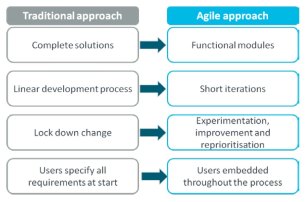
Scrum is like your mother-in-law , it points out all your faults – Anonymous
One test is worth a thousand expert opinions . Bill Nye The Science Guy
As we’ve grown, we need to focus on scale and on large engagements and those are only possible with Agile–there’s no other way. – Anonymous
If you do build a great experience, customers tell each other about that. Word of mouth is very powerful. – Jeff Bezos
Innovation distinguishes between a leader and a follower – Steve Jobs
It’s Kind of fun to do THE IMPOSSIBLE – Walt Disney
Defacts are not free. Somebody makes them, and gets paid for making them . – W.E.Deming
The best way to get a project done faster is to start sooner . – Jim Highsmith
Even the best planning is not so omniscient as to get it right the first time. – Fred Brooks
Before software can be reusable it first has to be usable. – Ralph Johnson
Inside every large program, there is a small program trying to get out. – C.A.R. Hoare
Everyone has a plan: until they get punched in the face. – Mike Tyson
A good plan today is better than a perfect plan tomorrow. – Proverb
Running a project without a WBS is like going to a strange land without a roadmap. – J. Phillips
If, on your team, everyone’s input is not encouraged, valued, and welcome, why call it a team? – Woody Williams
Project management is like juggling three balls – time, cost and quality. Program management is like a troupe of circus performers standing in a circle, each juggling-three balls and swapping balls from time to time. – G. Reiss
Rewards and motivation are an oil change for project engines. Do it regularly and often. – Woody Williams
Nobody knows how Honda is organized, except that it uses lots of project teams and is quite flexible. – Kenichi Ommae
You can copy structures, methods, rules, etc from another org. You can’t copy their culture though. – Martin Jensen
I believe you have to be willing to be misunderstood if you’re going to innovate. – Jeff Bezos
It’s not fail fast, fail often. It’s learn fast learn often. – Anonymous
Solve only the problems you have, not the ones you think you are going to have. – Anonymous
The greatest danger in times of turbulence is not the turbulence; it is to act with yesterday’s logic. – Peter Drucker






